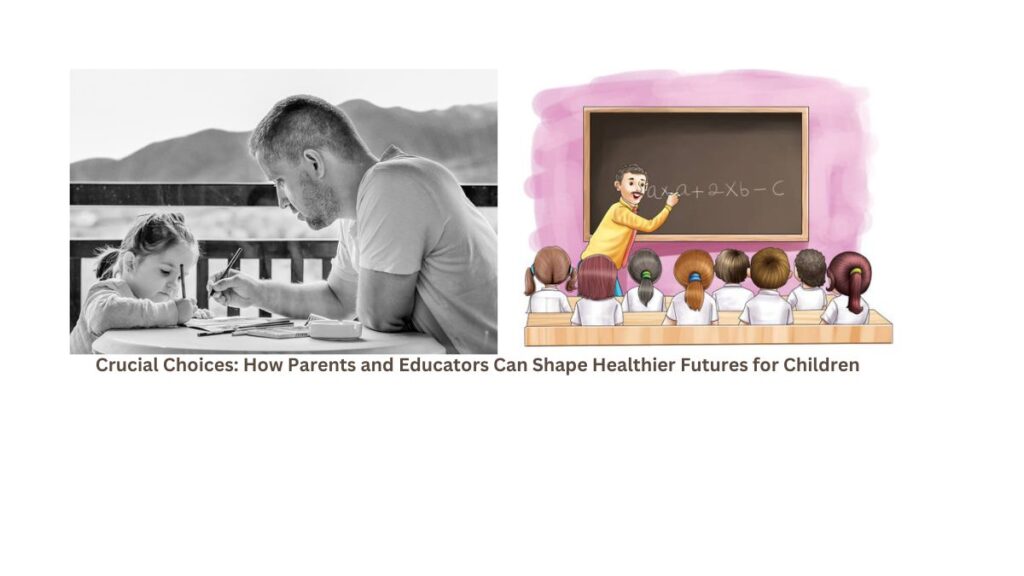Introduction:
Crucial Choices: How Parents and Educators Can Shape Healthier Futures for Children

Explore the pivotal role parents and educators play in steering the health and well-being of children in “Crucial Choices: How Parents and Educators Can Shape Healthier Futures for Children.” This insightful exploration unravels practical strategies and decisions that empower caregivers to navigate the complex landscape of children’s dietary habits and lifestyle choices. Join us in unlocking the secrets to fostering healthier futures for the next generation.
What practical tips and strategies can be offered to parents and educators, and caregivers to effectively navigate the challenges posed by the popularity of junk food among children? Additionally, how crucial is it to foster a positive food environment, educate children about nutrition, and promote healthier alternatives in addressing this issue?
Navigating the challenges posed by the popularity of junk food among children requires a collaborative effort from parents, educators, and caregivers. Fostering a positive food environment, educating children about nutrition, and promoting healthier alternatives are crucial components of addressing this issue. Here are practical tips and strategies for each group:

For Parents:
- Lead by Example:
- Demonstrate healthy eating habits by incorporating a variety of nutritious foods into family meals.
- Minimize personal consumption of junk food, as children often model their behavior after their parents.
- Educate About Nutrition:
- Teach children about the nutritional value of different foods, explaining the benefits of a balanced diet.
- Involve them in grocery shopping and meal preparation to make learning about nutrition interactive and engaging.
- Limit Availability:
- Control the availability of junk food at home by keeping a variety of healthy snacks readily accessible.
- Reserve unhealthy treats for special occasions to reinforce their occasional nature.
- Encourage Smart Choices:
- Empower children to make informed food choices by discussing the nutritional content of foods.
- Encourage them to opt for whole, minimally processed foods instead of highly processed snacks.
- Create Positive Food Associations:
- Associate healthy foods with positive experiences and rewards to make them more appealing.
- Celebrate achievements with non-food rewards, fostering positive reinforcement.
For Educators:
- Incorporate Nutrition Education:
- Integrate nutrition education into the curriculum to enhance students’ understanding of healthy eating.
- Organize workshops or guest speakers to provide practical insights into nutrition.
- Promote Healthy Eating Environments:
- Advocate for and implement policies that promote healthy food choices within schools.
- Collaborate with parents to reinforce consistent messages about healthy eating at home and school.
- Model Healthy Habits:
- Demonstrate healthy eating habits within the school environment, including staff lounges and school events.
- Encourage the use of healthy snacks in classroom celebrations.
- Engage in Physical Activities:
- Incorporate physical activities into the school routine to promote overall well-being.
- Reinforce the connection between physical activity and a healthy lifestyle.
For Caregivers:
- Communication with Parents:
- Maintain open communication with parents about children’s dietary preferences and habits.
- Share educational resources and tips on fostering a nutritious home environment.
- Provide Healthy Options:
- Offer a variety of nutritious snacks and meals to children in care, avoiding excessive reliance on processed foods.
- Collaborate with parents to align on food choices and reinforce healthy eating habits.
- Educational Programs:
- Implement age-appropriate educational programs on nutrition and healthy eating habits.
- Engage children in hands-on activities that promote positive attitudes toward healthy foods.
The Crucial Role of Fostering a Positive Food Environment:
- Establishing Healthy Habits: A positive food environment promotes the development of healthy eating habits from a young age.
- Shaping Preferences: Exposure to a variety of nutritious foods helps shape children’s food preferences and encourages them to make healthier choices.
- Reducing Appeal of Junk Food: By creating a positive food environment, the appeal of junk food may diminish as healthier options become the norm.
The Importance of Educating Children About Nutrition:
- Empowering Decision-Making: Nutrition education empowers children to make informed decisions about their food choices.
- Building Lifelong Skills: Teaching nutrition fosters lifelong skills that contribute to overall health and well-being.
The Value of Promoting Healthier Alternatives:
- Encouraging Variety: Promoting healthier alternatives encourages children to explore a variety of nutritious foods.
- Addressing Nutritional Gaps: By offering alternatives, caregivers address potential nutritional gaps in children’s diets.
What initiatives and movements are currently in place to curb the influence of popular junk foods on children’s health? Furthermore, how do communities, schools, and policymakers contribute to fostering a culture that prioritizes nutritious choices and actively supports the overall well-being of the younger generation?

Initiatives and Movements:
- Soda Taxes and Regulations:
- Some regions have implemented taxes on sugary beverages and introduced regulations to limit the marketing of unhealthy drinks to children.
- Healthy School Lunch Programs:
- Many countries have revamped school lunch programs to prioritize nutritious meals, reducing the availability of junk food in school cafeterias.
- Front-of-Pack Labeling:
- Governments and health organizations are advocating for clearer front-of-pack labeling to help consumers, including children and parents, make informed and healthier food choices.
- Media Literacy Campaigns:
- Initiatives focus on enhancing children’s media literacy to help them critically assess and understand the persuasive nature of marketing tactics used for junk foods.
- Corporate Responsibility Pledges:
- Some food and beverage companies have made pledges to reduce the sugar, salt, and fat content in their products, as well as to limit advertising to children.
Contributions from Communities, Schools, and Policymakers:
- Community Gardens and Farmer’s Markets:
- Communities are promoting access to fresh, locally sourced produce through community gardens and farmer’s markets, encouraging healthier food choices.
- Health and Wellness Programs:
- Schools are implementing comprehensive health and wellness programs that include nutrition education, physical activity, and mental health components to foster holistic well-being.
- Policy Implementation in Schools:
- Policymakers are enacting regulations that restrict the availability of sugary snacks and beverages in schools, emphasizing whole foods and healthier alternatives.
- Collaborative Parental Involvement:
- Communities and schools are encouraging parental involvement in shaping nutritional policies and providing resources to educate parents about making healthier food choices for their families.
- Advocacy for Physical Activity:
- Policymakers are advocating for increased physical activity in schools, promoting policies that ensure students have access to recess, physical education, and extracurricular activities.
- Food Education Programs:
- Communities and schools are implementing programs that teach children about nutrition, cooking skills, and the benefits of making healthy food choices.
- Support for Local Initiatives:
- Policymakers are providing support and funding for local initiatives that aim to improve community health, including projects that address food insecurity and increase access to nutritious foods.
- Media Regulations:
- Policymakers are exploring and implementing regulations on the advertising and marketing of unhealthy foods to children, aiming to reduce their exposure to persuasive messages.
- Public Awareness Campaigns:
- Communities, schools, and policymakers are working together to launch public awareness campaigns that emphasize the importance of a balanced diet and the potential health risks associated with excessive consumption of junk foods.
By combining efforts at the community, school, and policy levels, these initiatives aim to create an environment that prioritizes nutritious choices and actively supports the overall well-being of the younger generation. The collaboration between communities, schools, and policymakers is essential to address the multifaceted nature of the challenges posed by the influence of popular junk foods on children’s health.
Conclusion
In the realm of parenting and education, the impact of critical choices on children’s health cannot be underestimated. As we conclude our journey through “Crucial Choices,” it is clear that a positive food environment and informed decisions are the cornerstones of shaping resilient and healthier futures for children. Let this resource be a beacon for parents and educators, guiding them towards actionable steps to prioritize the well-being of the younger generation. Together, we can pave the way for a healthier tomorrow.
https://youtu.be/M98j3dB9SQI?si=33h8D__tEqXb0KQ2





